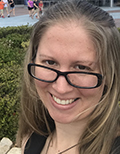Why did you apply to HASTAC?
I applied to HASTAC after learning about it from my professors within the Texts & Technology PhD program. The Texts & Technology program focuses on understanding the interdisciplinary possibilities between the humanities and technology. My background is in anthropology and applied linguistics, and I returned to graduate school to learn how I could find a career within the tech industry, and early in this process I learned about HASTAC. After learning about some of the work submitted to HASTAC I knew I wanted to learn more and become a part of this community.
What has been your favorite course so far as an instructor or student? Why?
My favorite course so far has been my informal learning design course, taught by Dr. Maria Harrington. This course has partnered with Orlando Museum of Art (OMA) to allow students to create a product that can be used to encourage informal learning opportunities at OMA. It has been my favorite course because Dr. Harrington guides her students through each step of the product creation process and gives us all a chance to create a project infused with our passion as well as understanding how to set up a product workflow and create a research design.
What do you want to do after you graduate?
After graduating from UCF in 2022, I want to work in the tech industry as a technical communicator. One of my greatest joys is helping others to understand how works have been created.
What’s something that people would be surprised to know about you?
Oftentimes people are surprised to learn that I’m actually severely hard-of-hearing. I grew up with progressive hearing loss and didn’t receive my first set of hearing aids until I was 23, so I have a lot of experience with adapting to my environment as needed.
What are some things that you wish you knew before you got into graduate school?
I wish I had known that it was actually okay to stop and take a breath before entering graduate school – everyone has their own way of deciding what is right for them, and there isn’t an official timeline we all have to follow. It’s a dangerous road to walk once you’ve begun comparing your work and schedule to your peers and professors – everyone has different goals and different strengths, and that is okay.
How do you envision HASTAC and/or higher education in 10 years? Where do you fit in?
In 10 years, I envision HASTAC to resemble an even larger integration of academics and industry professionals collaborating in research.
How does digital scholarship fit into your research or teaching?
As a future technical communicator, and with my specializing in digital media within my PhD program, digital scholarship is highly important. In my work as a graduate research associate in UCF’s Center for Humanities and Digital Research we are continually working to teach students about new digital resources that can be used in their own humanities research (at both the undergrad and graduate level).
What do you hope to accomplish with your research or teaching?
I hope that my research provides new examples of how digital media can be used to improve user engagement and understanding of content regardless of the user’s native language. In my dissertation research I want to explore how digital media and interactive digital models can be used to impart information to international users.
What are you currently reading, watching, or listening to?
I am currently watching The Mandalorian (I took the plunge and bough a Disney+ membership when the COVID-19 quarantine began).
What’s something we should ask you? What’s your answer?
I would ask: What is the hardest part of day-to-day life during grad school?
My answer: keeping up with the daily schedule, the days are usually pretty long and I’m always a bit sad when I think of how much time I spend away from my dog.
